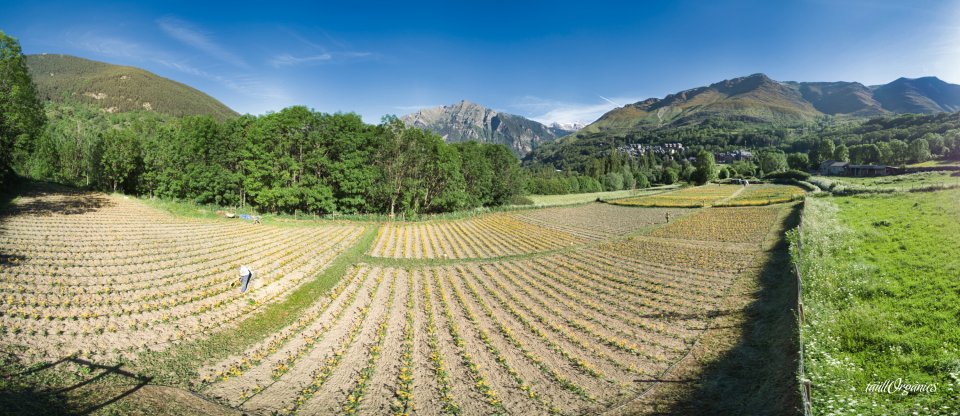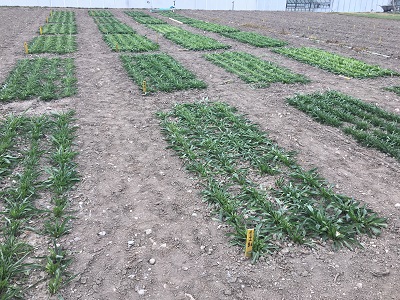
The production of medicinal and aromatic plants (MAPs) from wild collection or by cultivation raises environmental, social and economic issues. The demand for a wide variety of wild species is increasing with the growth of human needs and trade. There is an awareness that many wild plants are being overexploited, which many experts recommend incorporating into cropping systems, but several aspects that determine their viability have to be taken into account. An alternative is small-scale cultivation.
The trade of cultivated medicinal and aromatic plants do not exceed 1% of the total number of species used worldwide. Meanwhile, wild harvesting completes these crops providing rare species and being an important source of industrial raw material. High extraction in a particular area or of a specific species can lead to the disappearance of resources. Domestication and cultivation have certain advantages: 1. reliable botanical identification, 2. continuity of supply, 3. purchase agreements and long term contracts with clients, 4. selection of genotypes, 5. process control, 6. quality control and standards, and 7. certification.
Over exploitation of wild MAPs forces the cultivation of rosemary and thyme in Cevennes (France). Poor meadows management due to excecive fertilisation reduce the arnica resource and leads to the establishment of crops in Scotland, Poland, France or Spain.
Producers seek to diversify and preserve. "Syndicat des Simples" (France), a group of small producers, combines wild harvest with cultivation. In the Spanish Pyrennes, "Herbes de l'Alt Pirineu" conserves local species through regenerative agriculture and "Taüllorgànics" cultivates them for its cosmetic interest.
Lavandula angustifolia or Allium roseum are native species with cultivation potential (INTERREG SUDOE ValuePAM). In Switzerland, "Mediplant" already obtains Alpine MAPs varieties (edelweiss, rhodiola, genepi).
Cultivation is a feasible conservation option for threatened wild MAP's species, with high market demand. For the other species collected, the priority conservation option is a sustainable wild collection. There are also species that are not necessary to grow, because they are abundant, or of which small quantities are needed, or shrubs or trees that are not profitable to grow.
Small-scale cultivation can alleviate the decline in wild resources, be a diversified source of income and safer than the collection and, supply regional markets.
The domestication of the wild resource is not always technically possible, due to biological characteristics or ecological needs, requiring several years of research. Prices and sales guarantee also affect the economic viability of these new crops. And it can lead to the loss of genetic diversity, or discourage gatherers to conserve wild populations.
There are those who believe that cultivated plants have inferior quality to wild collected ones, but the right growing conditions in a crop can achieve the desired richness in active ingredients.
The recognition of the MAPs collector-cultivator profession is a formula to manage wild resources adequately, through the existence of the collector card, ecological or sustainable certification (FairWild), and compliance with strict rules, specifications and guidelines of good practices, which establish which species could be collected and which must be grown in each territory.
In addition, using ecological, biodynamic or permaculture practices in a crop, can allow to produce simulating the conditions of the natural environment.
Eva Moré, eva.more@ctfc.cat, http://apsb.ctfc.cat
Further information
Etat des lieux et perspectives des débouchés des petits producteurs de PPAM – GAAP – PAPDD 2015/2016 file:///C:/Users/eva.more/Downloads/rapport_-_gaap_agro-_plantes_a_parfum_-_2016.pdf
La cueillette a le vent en poupe. Le paysan d'Auvergne. Septembre 2012. file:///C:/Users/eva.more/Downloads/1-article_cueillette_journal_paysan_ayvergne.pdf
Les cueilleurs en chasse d'un meilleur statut. Humanité Quotidien, 27 Janvier 2011. file:///C:/Users/eva.more/Downloads/les_cueilleurs_en_chasse_docoun_meilleur_statut.pdf
Sandrine Boucher. Profession: cueilleur. Les 4 saisons 205 file:///C:/Users/eva.more/Downloads/cueilleurs-sandrine-boucher.pdf
Des plantes médicinales en pleine croissance. Plantes & Santé, nº 128. Octobre 2012. https://www.plantes-et-sante.fr/articles/on-en-parle/1993-les-plantes-medicinales-en-pleine-croissance
Schippamnn, U.; Leaman, D.; Cunningham, A.B. 2006. A comparison of cultivation and wild collection of medicinal and aromatic plants under sustainability aspects. R.J. Bogers, L.E. Craker and D. Lange (eds.), Medicinal and Aromatic Plants, 75-95.© 2006 Springer. Printed in the Netherlands https://www.researchgate.net/publication/277059910_Comparison_of_cultiva...
Sugier, D.; Sugier, P., Gawlik-Dziki, U. 2013- Propagation and Introduction of Arnica montana L. into Cultivation: A Step to Reduce the Pressure on Endangered and High-Valued Medicinal Plant Species. The Scientific World Jornal 2013:414363.
Resultados del debate de valorización de recursos silvestres. Taller formativo de transferencia a los clústeres empresariales. Estrategias de comercio de plantas aromáticas y medicinales. Proyecto INTERREG SUDOE ValuePAM. http://www.valuepam.eu/files/socios/andanatura/G3_A2_Taller%20formativo%20cluster_debate%20estrategias%20comercio.pdf
https://www.weleda.co.uk/arnica-annualharvest
https://www.taullorganics.com/
https://www.syndicat-simples.org/
https://www.herbesdelaltpirineu.com/
Comercial cultivation of arnica (Arnica montana), edelweis (Leontopodium alpinum) and marigold (Calendula officinalis) by Taüllorgànics company in the Catalan Pyrenees mountains (Taüll, LLeida, Spain). Autor: Taüllorgànics.

Domestication research of medicinal and aromatic plants in Mediplant (Switzerland) (http://www.mediplant.ch/images/prestations_agronomiques.jpg)
